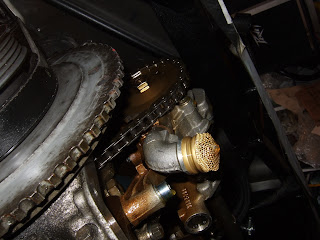Brakes
Firstly, and after a lot of trial and error, I fixed the braking problem (the rears were locking up first, which usually led to the back stepping out, and on one occasion to a 180º spin). Sadly I didn't discover the cause until after replacing:
- Rear callipers
- Front callipers
- All brake fluid
- Pads all round
Oil
This one is still only 90% fixed, but that's probably good enough. There was a small but significant leak, which turned out to be from a little valve on the side of the block (a pressure regulator), where an O-ring had perished. Fortunately I had a suitable sized O-ring kicking about the garage, so, apart from the difficulty of accessing this with the engine in the car, this was a pretty easy fix.
The offending oil pressure valve.
Unfortunately there seems to still be a tiny leak from the sump (which I removed to sort out the oil pump after fitting the engine). It's probably not big enough for me to want to remove the sump again to fit a new gasket (really wish I'd fitted a new gasket first time round) though, so I will just keep an eye on it.
Setup
Thanks to Jason for lending me his wheel alignment kit. Having got all the wheels pointing the right direction, the car feels a lot more stable and controlled. Toe-out at the rear has been changed to toe-in, which has made the handling safer, if less entertaining.
I've also experimented with a couple of different sets of springs, but so far am sticking with the original set at 350 front and 180 rear. These are a touch on the soft side, leading to an amount of body roll, but grip and ride are good so I think I'll probably track the car like this and see how it handles on track.
Jason has also passed on a longer set of wishbones for the front, which will give me more steering lock, which is badly needed, not so much for driving around where there is just about enough lock, but more for parking and manoeuvring. These are yet to be fitted (I'll need to get some longer tie-rods to match), but this should keep me busy in the New Year.
Cycle Wings
Once again, the brackets holding these on broke, this time at a very inconvenient place (on a dual carriage way slip road in rush hour, with no hard shoulder). Not fun at all.
Peter has provided new brackets, and I've experimented a little with how I'm attaching the new wings as I want to keep them detachable, but don't want exposed bolts on the top side. I've bonded them to a bracket with studs pointing down, and then bolted the studs to the main cycle wing bracket. Hopefully the sikaflex is strong enough to keep them attached (and hopefully I've welded the studs on strongly).
New cycle wing with bracket and tube for wiring bonded on.
Main bracket ready for cycle wing.
Fuel Economy
As always, this remains a tricky problem. I saw some improvements when I removed the exhaust, and remounted it at a more natural angle. Previously the supplied brackets meant that the tubes were at a slight angle where they pushed into each other, creating a space where oxygen could be drawn in upstream of the lambda sensors (which, on detecting unused oxygen, would cause the ECU to compensate with extra fuel). A combination of new brackets and replacing the gun-gum exhaust paste I'd previously used with RTV sealant seemed to improve matters, getting fuel economy briefly up to the low thirties... but then it dropped back to low twenties again.
I've since discovered the port on the side of the engine where clean air is injected into the exhaust to improve emissions, which I had blocked off, had maybe not been as well blocked as I thought, which could be a potential source of oxygen getting into the exhaust. I've since fitted the BMW part for blocking this off (turns out the South African market doesn't care about emissions, so they make a suitable part for them), which may or may not improve things.
Other
When setting out for one test drive, I heard a scary sounding grinding noise (it can be heard in the first few seconds of this video):
Not a sick engine. At least, not as far as I know...
Fortunately, this didn't mean my engine was dead - it turned out just to be the water pump bearing failing. Removing the aux belt it was very clearly starting to seize up, so I got a new pump fitted and problem solved. I didn't replace the gasket as it was firmly stuck to the block and I was afraid of scratching the block and ruining the seal forever - this turned out the be the right choice as it didn't leak. I suspect that the tensioner may be on the way out too, but it's not making any funny noises so it will do for now.
I also finally got round to putting a hinge on the front nosecone so that I can easily access the radiator. Another job I wish I'd done ages ago - improving access always seems to be worth investing time in, something I could have benefitted from realising at the start.
So this leaves the car with working brakes, not overly leaking, and with all the wheels aligned and cycle wings fitted... could this be the long hoped for point after which it's all just fine tuning?






















































